Why Do Construction Project Managers Use Gantt Charts?
Gantt charts help construction managers keep projects on track. They lay out tasks clearly, give timelines visibility, display sequencing and subproject dependencies, and show delays. Teams stay organized, and everyone knows their role. Gantt charts bring order to complex builds.
Learn more about Gantt charts, including how they can help keep a project on track and how they’re used across industries.
Residential Build Gantt Template

Download a Residential Build Gantt Template for
Excel
| Google Sheets
When to Use this Template: Use this template for ground-up home construction projects, from permitting through final inspection. The template works well for builders, general contractors, or project managers.
Notable Template Features: This template includes phased construction layout, dependencies, milestone markers, and resource assignments. It’s built for easy tracking across teams and timelines.
Check out these construction project management templates for Excel.
Residential Remodel Gantt Template

Download a Residential Remodel Gantt Template for
Excel
| Google Sheets
When to Use this Template: The residential remodel template is perfect for kitchen, bath, or whole-home renovations. It helps remodelers manage overlapping trades and active job sites.
Notable Template Features: This template offers a compact structure with clear phases, from demolition through final punch list, as well as subcontractor assignments and real-time progress tracking.
Commercial Tenant Improvement Gantt Template
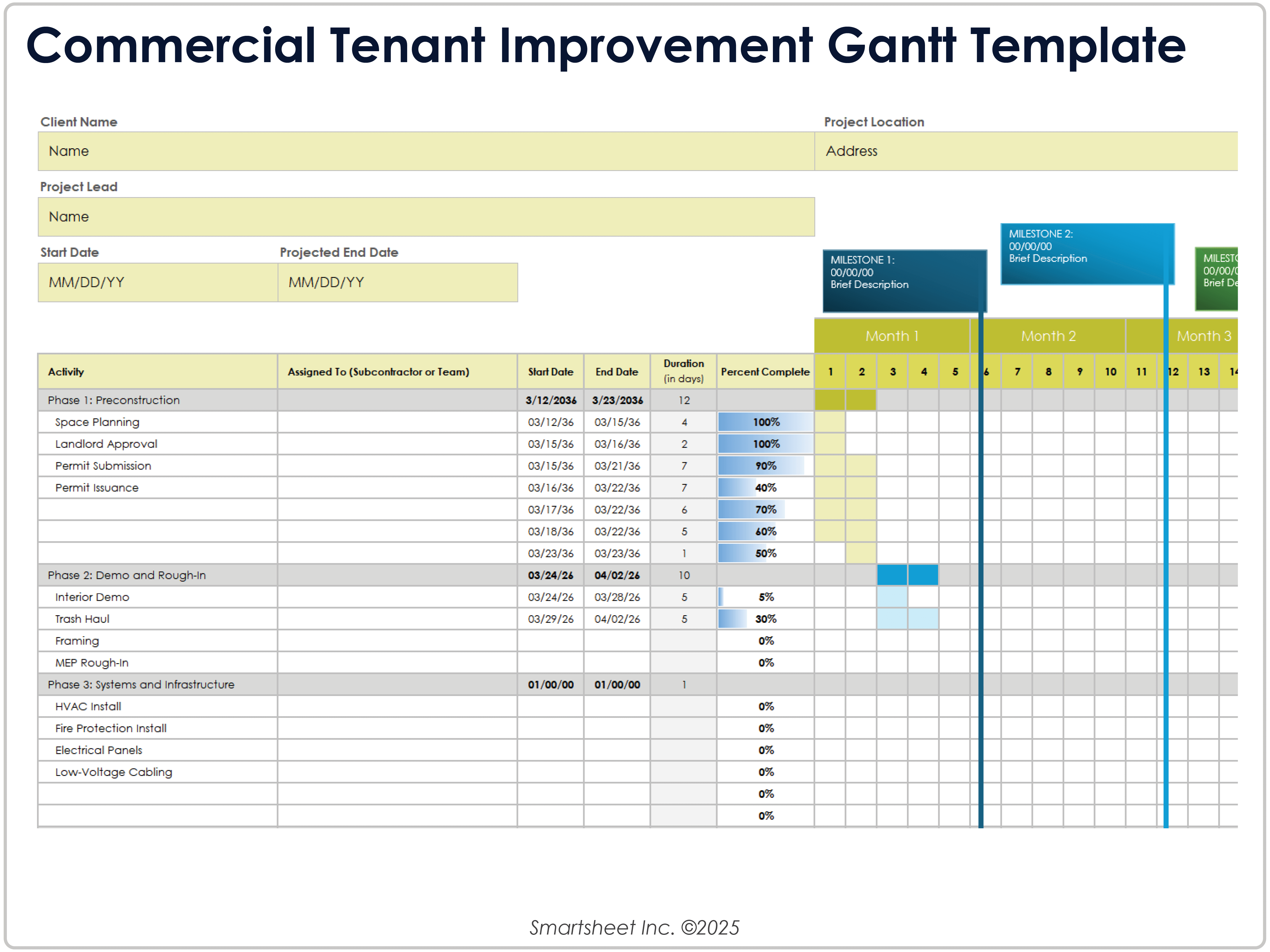
Download a Commercial Tenant Improvement Gantt Template for
Excel
| Google Sheets
When to Use this Template: This template helps you coordinate multiple contractors on a tight timeline when improving office, retail, or light medical leased spaces.
Notable Template Features: You can use this template to track approvals, inspections, and phased build-out. You’ll find color-coded stages, task dependencies, and contractor assignments on this template.
Construction Project Gantt Chart Template
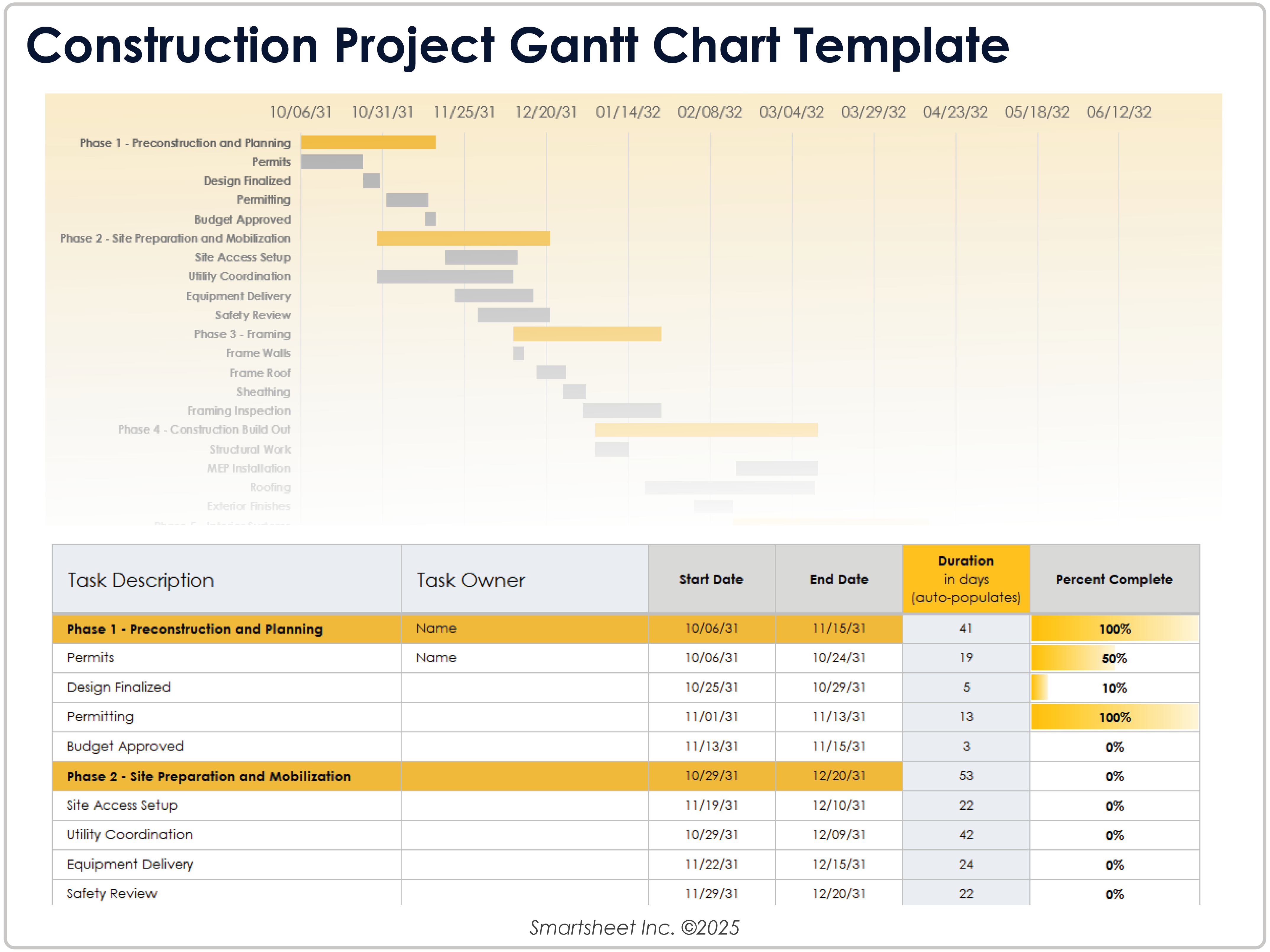
Download a Construction Project Gantt Template for
Excel
| Google Sheets
When to Use this Template: Small developers, facility teams, and nonprofits can use this general-purpose template for a wide range of construction-related projects.
Notable Template Features: This template provides adaptability and clarity, with flexible phase structure, editable timelines, milestone markers, and resource columns.
For a deeper look at how Gantt charts fit into broader planning, explore our construction project management guide.
Infrastructure Upgrade Gantt Template
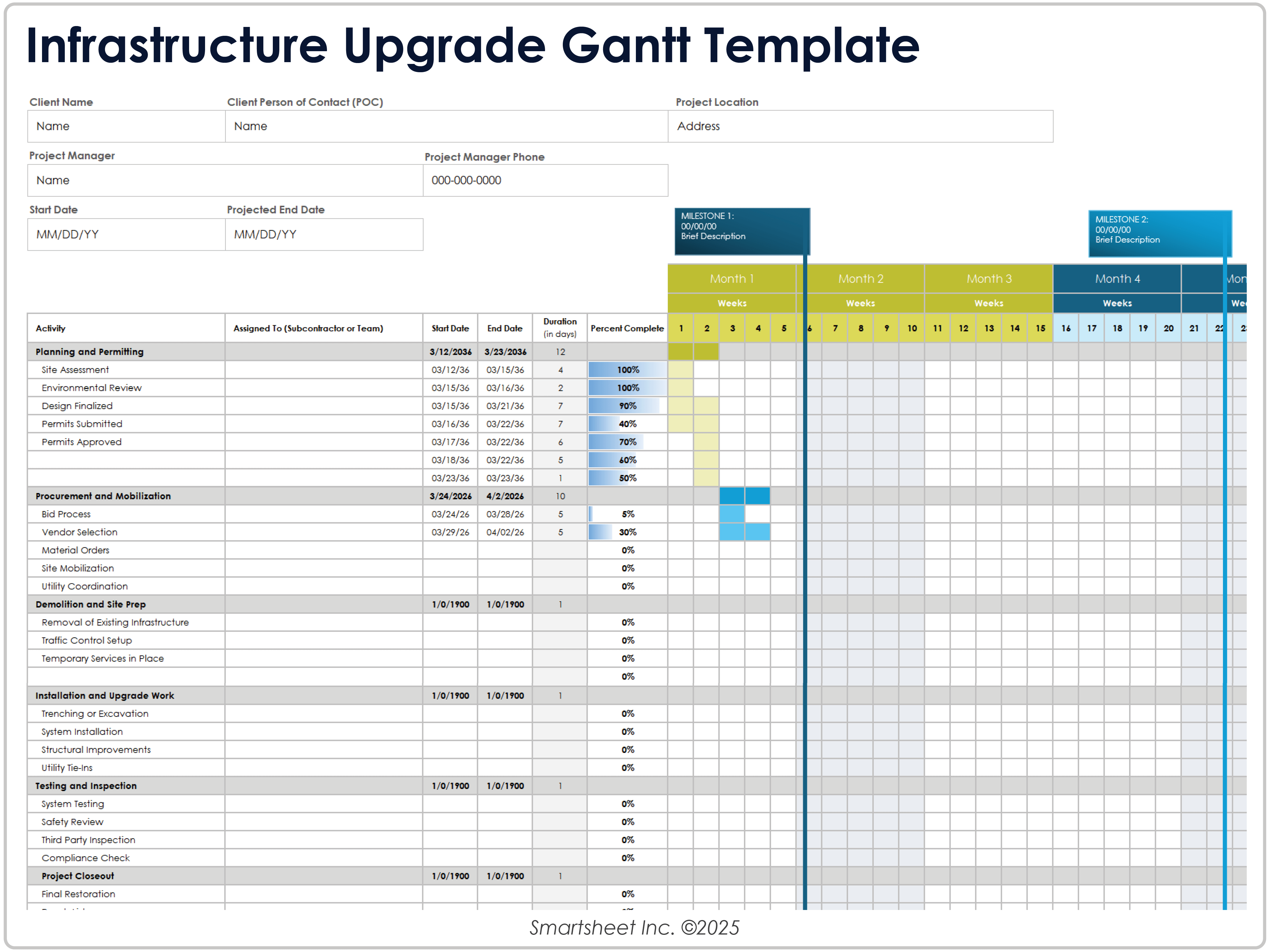
Download an Infrastructure Upgrade Gantt Template for
Excel
| Google Sheets
When to Use this Template: You can use this template for planned utility, public works, institutional upgrades, and other complex, multiphase projects.
Notable Template Features: On this template, you’ll find compliance checkpoints, phased install tasks, and clear permitting workflows. In addition, it supports longer timelines and multiple crews.
HVAC Install Gantt Template
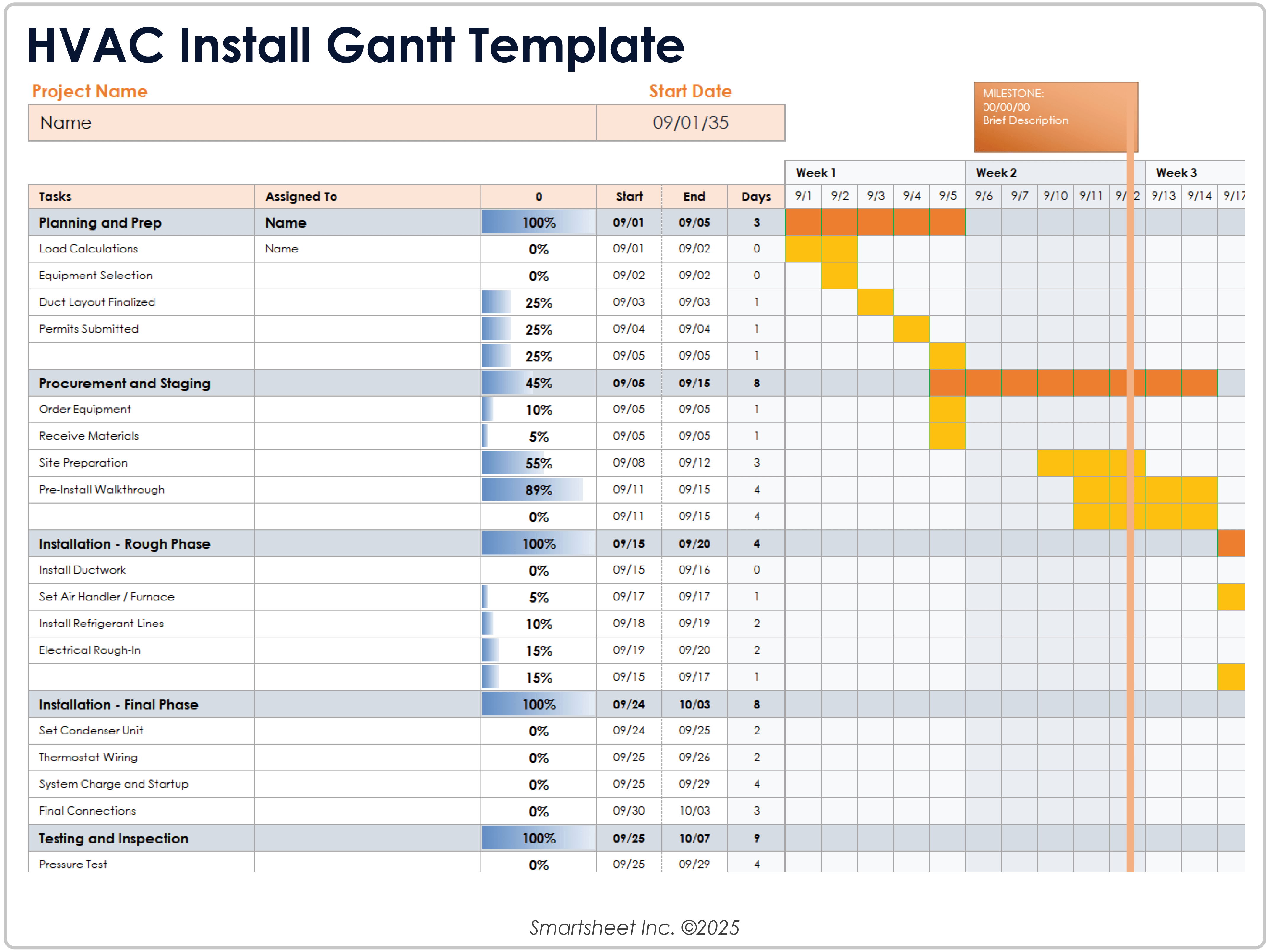
Download an HVAC Install Gantt Template for
Excel
| Google Sheets
When to Use this Template: This template is perfect for HVAC installations in both residential and light commercial projects, as well as both new construction and retrofits.
Notable Template Features: This template breaks work into rough-in phase tasks and final install tasks, includes steps for getting permits and scheduling inspections, and allows trade-specific assignments.
Landscaping Project Gantt Template
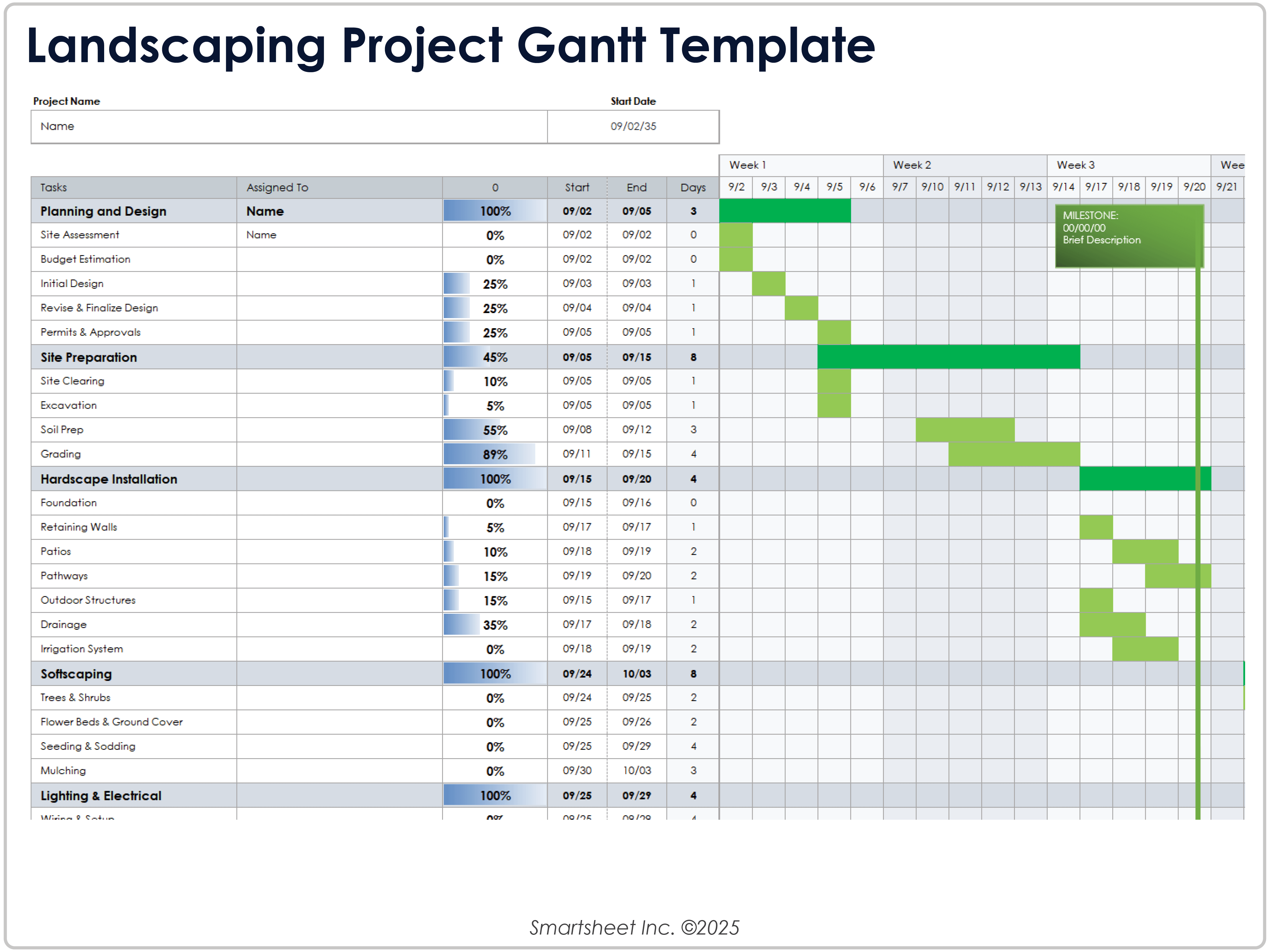
Download a Landscaping Project Gantt Template for
Excel
| Google Sheets
When to Use this Template: Use this template for residential or light commercial landscaping work. Design-build teams and landscaping contractors will get a lot of use from this template.
Notable Template Features: You can cover design, site prep, hardscape, planting, and closeout phases with this template, which is color-coded by phase, with room for custom task lists and crew assignments.
How to Build a Construction Gantt Chart
To build a construction Gantt chart, first list all project tasks. Designate phases, such as site preparation, framing, and finishes. Assign start and end dates to each task, and set dependencies to prevent tasks from starting prematurely. Add milestones to track goals, then update the chart as work progresses.
For a deeper walkthrough, check out this guide on how to prepare a construction schedule. See this collection of Gantt chart templates for options for other industries.
Benefits of Using Smartsheet for Construction Gantt Charts
Smartsheet turns a standard construction Gantt chart into a dynamic project hub. Instead of managing separate spreadsheets, budgets, and files, everything lives in one place — with live updates everyone can see.
Here are some benefits of using Smartsheet for construction Gantt charts:
- Critical Path Tracking: Smartsheet Gantt charts allow you to highlight the critical path to see what tasks affect your final delivery date. You can see the downstream impact in real time as dates shift or new tasks are added, and you can use the baselines feature to compare actual versus planned project schedules, calculate variance, and set realistic expectations.
- Real-Time Collaboration: Teams on site and in the office can stay on the same page, track changes as they happen, and keep projects moving. Unlike static formats, Smartsheet supports real-time collaboration, document sharing, automated alerts, and flexible reporting, all in a cloud-based platform built for complex construction work. You can share Smartsheet Gantt charts with both internal and external stakeholders to provide visibility into project timelines, progress, and task dependencies.
- Visual Tracking: The visual timelines offered by Smartsheet Gantt charts allow clear scheduling and task visibility so that you can spot delays and visualize work in sequence across projects and programs.
Learn more about how Gantt chart software works in Smartsheet, including key features, use cases, and tips for building interactive Gantt charts that keep teams aligned and on schedule.
Streamline Your Construction Projects With Smartsheet for Construction
From pre-construction to project closeout, keep all stakeholders in the loop with real-time collaboration and automated updates so you can make better, more informed decisions, all while landing your projects on time and within budget.
The Smartsheet platform makes it easy to plan, capture, manage, and report on work from anywhere, helping your team be more effective and get more done. Report on key metrics and get real-time visibility into work as it happens with roll-up reports, dashboards, and automated workflows built to keep your team connected and informed.
When teams have clarity into the work getting done, there’s no telling how much more they can accomplish in the same amount of time. Try Smartsheet for free, today.
Construction Gantt Chart FAQs
A construction Gantt chart includes tasks, start and end dates, and durations. It shows dependencies between tasks, assigns resources and responsibilities, and tracks progress over time. It uses bars to visualize schedules. It might include baselines, milestones, and color-coding for clarity.
To get started on populating your Gantt chart, learn how to use a work breakdown structure (WBS) for construction to outline all project tasks and deliverables. With a clear WBS, you can build a functional Gantt chart much more easily.
Using a Gantt chart to manage subcontractors helps you track tasks, dates, and dependencies. Use the chart to list each subcontractor’s tasks. Add start and end dates, and link tasks to show dependencies and delays. Group crews with colors or swimlanes. Update schedules as work progresses, and share the chart with all teams in real time.
To see real examples of subcontractor scheduling in action, browse these construction schedule templates designed for project coordination.
To read a construction Gantt chart, start by reviewing the timeline across the top and the list of tasks along the side. Each horizontal bar represents a task’s duration and placement in the schedule. Arrows or lines indicate dependencies between tasks, while overlapping bars show which tasks happen simultaneously. Progress is often tracked using shading or “percent complete” indicators in the bars.
To understand which tasks are most critical to your schedule, learn how the critical path method for construction identifies time-sensitive work.
A project chart is a broad visual overview that shows phases or milestones. A Gantt chart focuses on specific task duration and sequencing. It uses timelines and dependencies. Both can work together, but they serve different purposes in project planning and management.